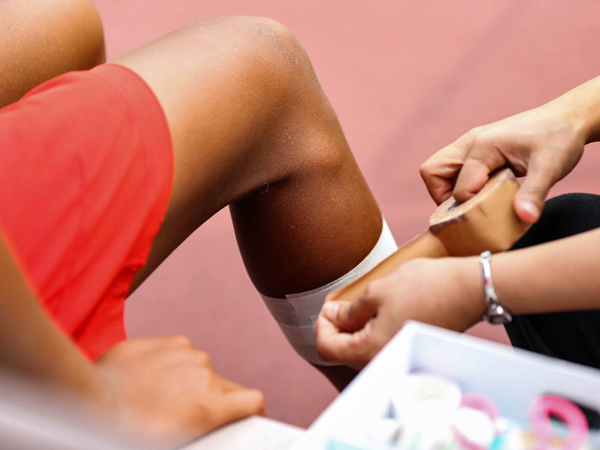What are some of the common tennis injuries?
File Photo Credit: SportSG
Now that you know how to serve and return a serve in tennis, it's time to look at how not to injure yourself while making these serves. According to the British Journal of Sports Medicine, there are approximately 54 injuries per 1,000 Tennis matches.
The injury risk in tennis is relatively low compared to other sports and can be further reduced if players are aware of the common injuries and precautions taken to avoid them.
These are the 5 most common injuries in tennis with instructions on how to prevent them.1. Shoulder Injuries
Tennis players’ shoulders are more prone to injuries than any other part of the body due to the repetitive and high-impact strokes that cause a heavy amount of stress on the shoulders. When overexerted, the tendons of the Rotator Cuff, consisting of muscles and tendons at the upper-arm and shoulder blade, may be inflamed, developing tendinitis.
This produces pain with overhead motions such as serving or even raising your arms. Shoulder overuse injuries are usually due to poor conditioning and strength of the rotator cuff muscles. Hence, it is important to have core strengthening exercises to prevent this from happening.
Prevention: As suggested by Nicholas Mihelic, the Managing Director of The Sport and Spine Institute, South Carolina, changing your serving technique is a good prevention against shoulder injuries. In a serve, increase the angle between your arm and side to more than 90°, ideally 135° will lessen the chance of Rotator Cuff injuries.
2. Tennis Elbow
“Tennis elbow” or lateral epicondylitis, is the inflammation of the tendons that join the forearm muscles on the outer part of the elbow. These forearm muscles are linked to the extension of the wrist and fingers. It is also the muscle most frequently used when the Tennis ball contacts the racquet.
Overexertion is the most common cause of this injury, followed by a forceful extension causing a traumatic blow to the forearm muscles.
Prevention: Preventions of “Tennis Elbow” include firstly, mastering the correct techniques for stroke execution. Secondly, proper strengthening through gradual increase of forearm muscular strength which in turn increases joint stability. Thirdly, doing an equipment check by ensuring that there is adequate string tension and the grip size of the tennis racquet is a proper fit.
If it is too small, it may cause you to grip the racket too hard. Prolonged or over-gripping may create unnecessary stress on your forearm muscles and promote the risk of “Tennis Elbow”.
For those who have a history of similar injuries, it will be good to wear a tennis elbow compression strap as a form of prevention.
3. Wrist Injuries
A common mistake by beginners is the intentional high-impact swing of the wrist in a snapping effect. It will not only damage the serve but also your wrist. When executing a stroke, allow your wrist to whip forward naturally without any deliberate effort on your part. The power of the stroke should be from the upper-arm and the body rotational movement.
4. Ankle Injuries
Ankle injuries are common in Tennis due to the frequent sudden sideway movements causing the ankle to twist. A twisted ankle may in turn damage the ligaments and soft tissues near the ankle resulting in a sprain.
Prevention:
One way to prevent ankle injuries is to apply an ankle brace. Even Tennis professionals like Andrew Murray and Roger Federer use them. Physio Room has proved the effectiveness of ankle injury prevention with the application of an ankle brace. “The injury incidence in people with taped ankles was 4.9 ankle sprains per 1,000 participant matches, compared with 2.6 ankle sprains per 1000 participant matches in students wearing ankle braces. This compared with 32.8 ankle sprains per 1,000 participant matches in subjects that had no taping or bracing.”
5. Overuse injuries
The British Journal of Sports Medicine suggests the following preventions which work for all types of injuries:
- Physical training specifically targeting injury‐prone movement patterns
- Education on Tennis injuries
- Interval musculoskeletal screening
- Frequent equipment checks
- Adjustments including shoes, racquets, strings, and balls as well as court surfaces.
The majority of injuries in tennis are due to overuse with only one-third of the injuries in due to traumatic injuries or an acute event. Hence, the importance of taking frequent breaks should not be overlooked.
The freedom to plan breaks is one of the benefits of playing leisurely, so do put that to your advantage as its always better to be safe than sorry.
References
- American Academy of Orthopaedic Surgeons (2009) “Tennis Elbow (Lateral Epicondylitis)” Online orthopaedic article retrieved from: http://orthoinfo.aaos.org/topic.cfm?topic=a00068
- British Journal of Sports Medicine. 40(5), 415-459, 2006.
- Kolowich P. (2010) “Tennis Injury Prevention” Online tip sheet retrieved from: http://www.stopsportsinjuries.org/files/pdf/AOSSM_Tennis.pdf
- Mihelic N. “Are You an Ace on the Court?” The Sport and Spine Institute. Online article retrieved from: http://www.hughston.com/hha/a.tennisinjuries.htm
- National Center for Biotechnology Information, U.S. National Library of Medicine “Tennis injuries: occurrence, aetiology, and prevention” Online journal extract retrieved from: http://www.ncbi.nlm.nih.gov/pmc/articles/PMC2577485/
- Physio Room “Top 5 Tennis Injuries” Online sports guide retrieved from: http://www.physioroom.com/sports/tennis/injuries-introduction.php
To receive the latest updates on the happenings in the Singapore sports scene, or to find out more about some of the latest programmes on offer at ActiveSG, like our Facebook page here.
Are you a kid trying to learn the basics to tennis? Or perhaps a parent trying to introduce your child to the game of tennis?At the ActiveSG Tennis Academy, we are serving up an ace when it comes to learning and enjoying the game.
With a structured pathway to unleashing potential, our students have an opportunity to enjoy playing tennis before learning to play at the highest level.
Helmed by professional coaches, our students are engaged at every level of development. From fundamental movement skills to core tennis skills, the programmes are designed to be fun, yet challenging. Sign up for the ActiveSG Tennis Academy by registering here.




